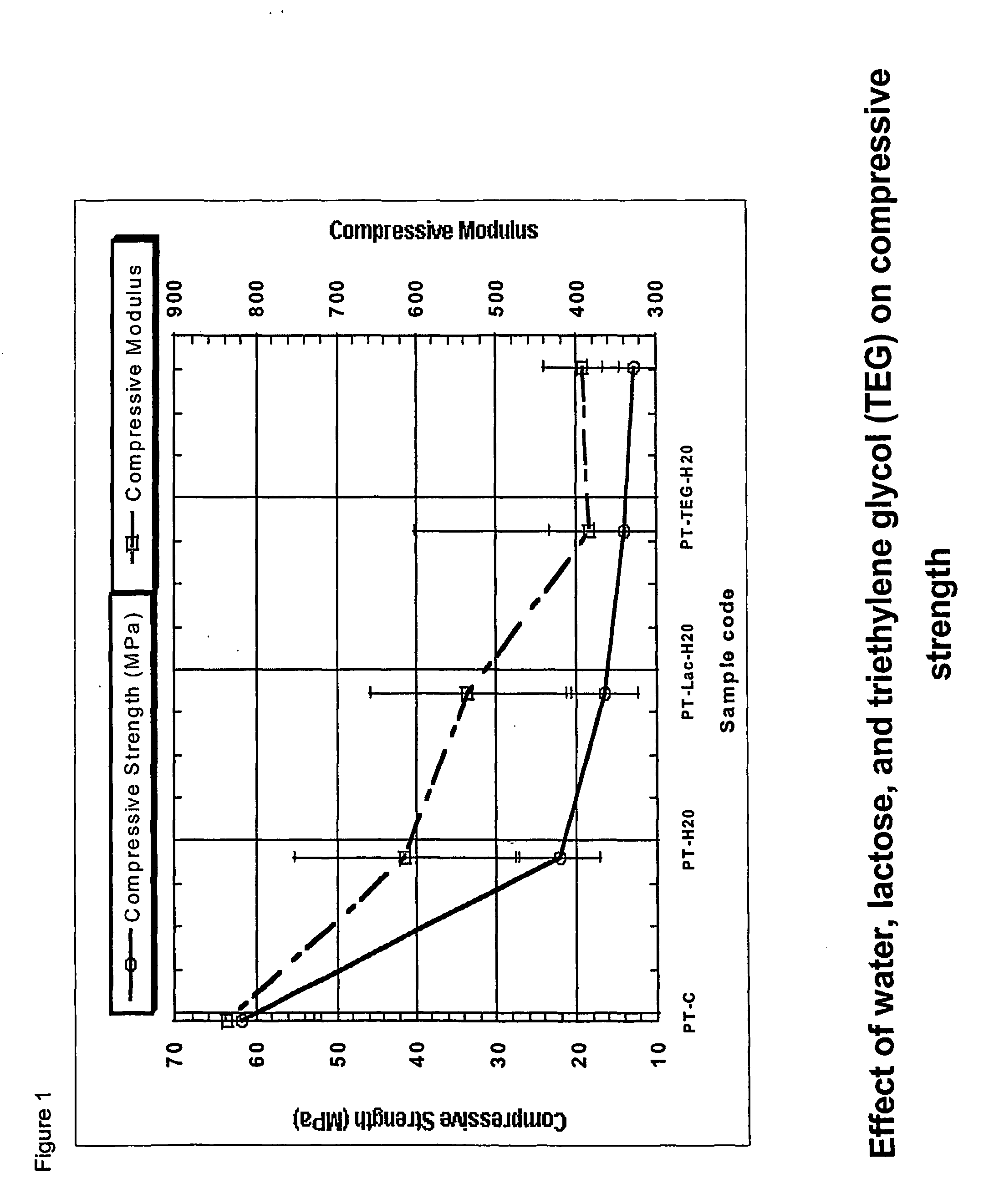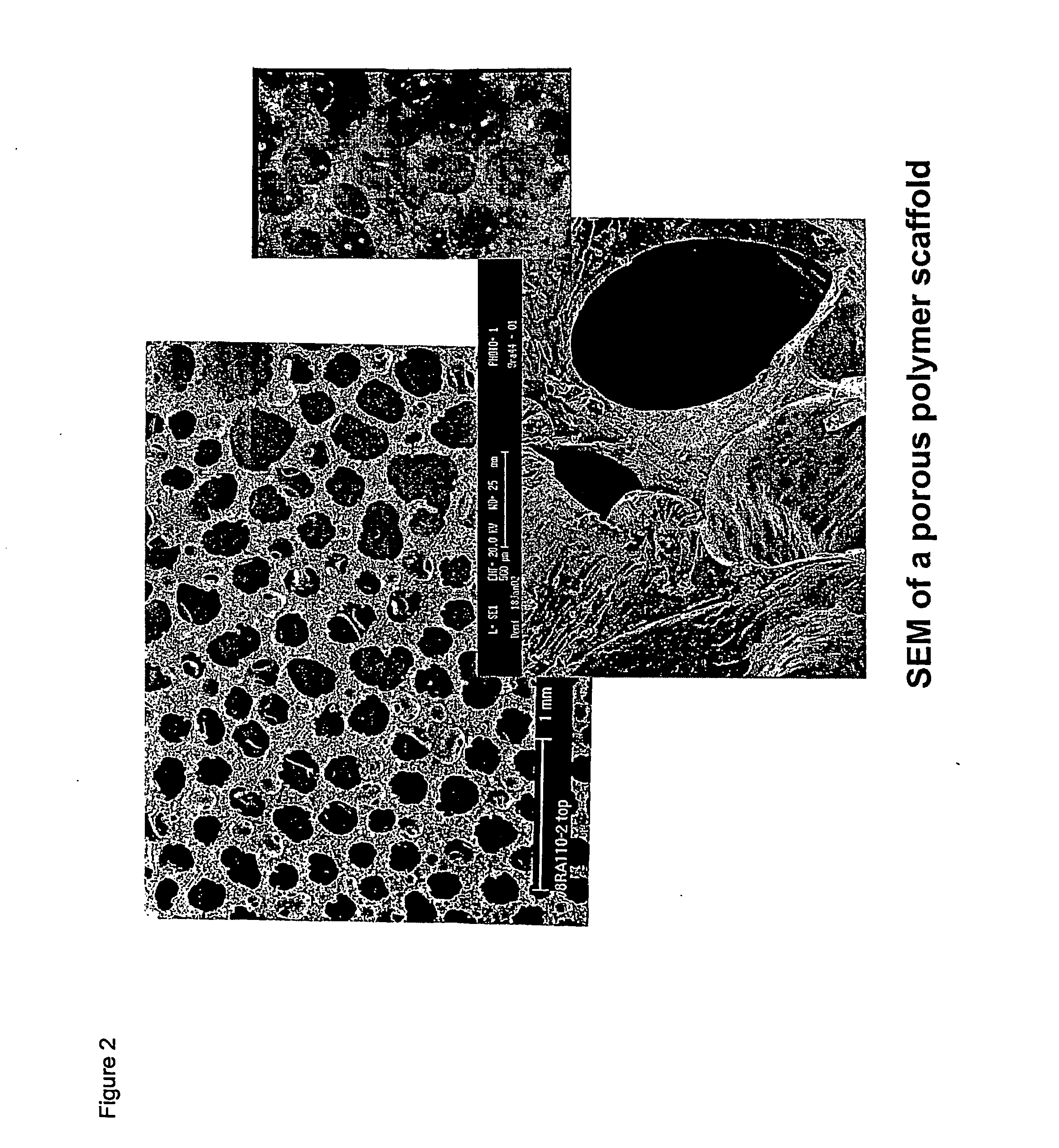Biodegradable polyurethane/urea compositions
a technology of biodegradable polyurethane and composition, which is applied in the direction of synthetic polymeric active ingredients, joint implants, prosthesis, etc., can solve the problems of rapid loss of mechanical properties, difficulty in processing, and many currently available degradable polymers do not meet all of these requirements, and achieve low shrinkage
- Summary
- Abstract
- Description
- Claims
- Application Information
AI Technical Summary
Benefits of technology
Problems solved by technology
Method used
Image
Examples
example 1
[0111] Materials: Pentaerythritol (Aldrich) was dried under vacuum (0.1 torr) at 80° C. over night. Methyl 2,6-diisocyanato hexanoate (MLDI, Kyowa Yuka Co., Ltd, Japan) and stannous 2-ethyl hexanoate (SEH, Sigma Aldrich) were used as received. All the glassware used was thoroughly cleaned and dried at 105° C. overnight in an oven before use.
[0112] Predried pentaerythritol (4.818 g) was weighed in a dry three-neck flask equipped with a magnetic stirrer, nitrogen inlet and drying tube. Methyl 2,6-diisocyanato hexanoate (MLDI) (30.04 g) was then added to the flask followed by catalyst stannous 2-ethyl hexanoate (0.1 wt %, 0.0348 g) under nitrogen. The reaction mixture was stirred and heated to 50° C. for 72 h under nitrogen atmosphere. The homogenous polymer mixture was degassed under vacuum (0.1 torr) at 50° C. before it was transferred to a vial under nitrogen atmosphere and stored in the refrigerator. The molecular weight and viscosity of the prepolymer were determined by gel perme...
example 2
[0116] Materials: Tripentaerythritol (Aldrich) was dried overnight under vacuum (0.1 torr) at 800C. MLDI and SEH were used as received.
[0117] Tripentaerythritol (6.98 g) was weighed in to a dry three-neck round bottom flask equipped with a magnetic stirrer, nitrogen inlet and drying tube. Methyl 2,6-diisocyanato hexanoate (31.81 g) was weighed separately and added to the flask followed by catalyst stannous 2-ethyl hexanoate (0.1 wt %, 0.038 g) under nitrogen. The reaction mixture was stirred and heated at 50° C. for 7 days under nitrogen atmosphere. The homogenous polymer mixture was degassed under vacuum (0.1 torr) at the above temperature for about an hour before it was transferred to a vial under nitrogen atmosphere and stored in the refrigerator. Prepolymer was analysed for molecular weight and viscosity using the methods described in Example 1.
[0118] The number average molecular weight and polydispersity of the prepolymer were 827 and 1.36, respectively. The instantaneous vis...
example 3
[0119] Materials: D-Glucose (Aldrich) was dried overnight in a vacuum oven (0.1 torr) at 80° C. MLDI and stannous 2-ethyl hexanoate were used as received.
[0120] Predried D-Glucose (5.0 g) was weighed in to a dry three-neck round bottom flask equipped with a magnetic stirrer, nitrogen inlet and drying tube. Methyl 2,6-diisocyanato hexanoate (MLDI) (29.44 g) was then weighed separately and added to the flask followed by catalyst stannous 2-ethyl hexanoate (0.1 wt %, 0.0348 g) under nitrogen. The reaction mixture was stirred and heated at 50° C. for 72 h under nitrogen atmosphere. The homogenous polymer mixture with then degassed under vacuum (0.1 torr) at 50° C. before it was transferred to a vial under nitrogen atmosphere and stored in the refrigerator. The prepolymer was analysed by GPC and Rheometer (CLR-10) using methods described in Example 1.
[0121] The prepolymer number average molecular weight was 1430 and the polydispersity was 1.75. Instantaneous viscosity was 1.5×105 cSt a...
PUM
| Property | Measurement | Unit |
|---|---|---|
| compressive strength | aaaaa | aaaaa |
| size | aaaaa | aaaaa |
| temperature | aaaaa | aaaaa |
Abstract
Description
Claims
Application Information
 Login to View More
Login to View More - R&D
- Intellectual Property
- Life Sciences
- Materials
- Tech Scout
- Unparalleled Data Quality
- Higher Quality Content
- 60% Fewer Hallucinations
Browse by: Latest US Patents, China's latest patents, Technical Efficacy Thesaurus, Application Domain, Technology Topic, Popular Technical Reports.
© 2025 PatSnap. All rights reserved.Legal|Privacy policy|Modern Slavery Act Transparency Statement|Sitemap|About US| Contact US: help@patsnap.com



